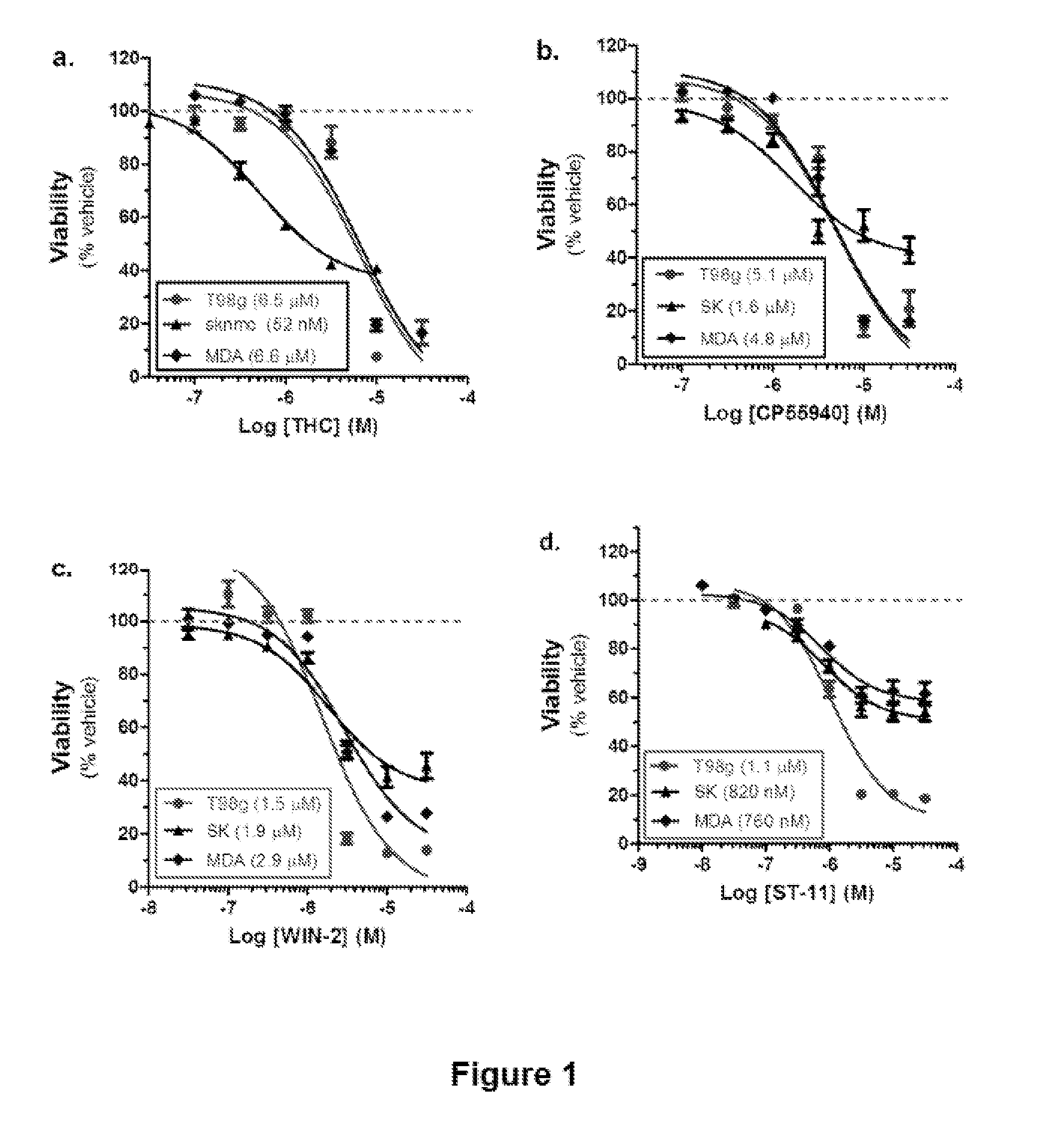Compositions and Methods for Treating Malignant Astrocytomas
a technology of astrocytoma and composition, applied in the field of brain tumor treatment methods and pharmaceutical compositions, can solve the problems of one of the most devastating cancers, and achieve the effect of improving the treatment of brain tumors
- Summary
- Abstract
- Description
- Claims
- Application Information
AI Technical Summary
Benefits of technology
Problems solved by technology
Method used
Image
Examples
example 1
Synthesis of (9-ethyl-9H-carbazol-3-yl)(4-methylnaphthalen-1-yl)methanone, ST-34
[0275]
Synthesis of 9-ethyl-9H-carbazole (compound 1.1)
[0276]A mixture of carbazole (10 g, 59.80 mmol), ethyl bromide (6.65 mL, 89.75 mmol), and powdered NaOH (4 g, 100 mmol) in dry acetone (100 mL) was refluxed for 16 h under nitrogen. The organic solvents were evaporated in vacuo. The obtained residue was diluted with water (50 mL) and extracted into tert-butyl methyl ether (100 mL). The organic layer was washed with water, brine, dried (MgSO4), filtered, and evaporated in vacuo. The obtained residue was crystallized from ethanol. Yield: 8.62 g (74%); mp 70-71° C.
Synthesis of (9-ethyl-9H-carbazol-3-yl)(4-methylnaphthalen-1-yl)methanone. ST-34
[0277]Under argon atmosphere, AlCl3 (309 mg, 2.32 mmol) was added to a solution of carbazole 1.1 (426 mg, 2.18 mmol) in dry benzene (30) mL, and the obtained solution was placed in an ice-water bath for 20 min. 4-methyl-1-naphthoyl chloride (Huffman et al., Bioorgan...
example 2
Synthesis of 5-ethyl-7-methoxy-2-[(4-methylnaphthalen-1-yl)carbonyl]-1H,2H,3H,4H,5H-pyrido[4,3-b]indole; ST-33
[0278]
2.1. Synthesis of ethyl 7-methoxy-3,4-dihydro-1H-pyrido[4,3-b]indole-2(5H)-carboxylate (compound 2.1)
[0279]
[0280]Title compound was prepared by heating phenylhydrazine hydrochloride (4.750 g, 27.2 mmol) and 1-carbethoxy-4-piperidone (5.588 g, 32.64 mmol) in anhydrous ethanol (150 mL) at reflux for 16 h. The solvent was evaporated in vacuo, and the obtained residue was purified by silica gel chromatography using ethyl acetate / heptanes in different proportions to afford the title compound as a white solid. Yield 4.52 g (61%).
Synthesis of ethyl 5-ethyl-7-methoxy-3,4-dihydro-1H-pyrido[4,3-b]indole-2(5H)-carboxylate (compound 2.2)
[0281]
[0282]Sodium hydride (131 mg, 3.28 mmol) in the form of a 60% dispersion in oil was washed with pentanes (25 mL) on a glass filter and added in small portions to a solution of 2.1 (0.5 g, 1.82 mmol) in DMF at 0° C. under N2. Then, ethyl bromi...
example 3
Cell Culture
[0287]All cell lines were grown at 5% CO2 and 37° C. in cell culture growth media consisting of DMEM+GlutaMAX™-I (Gibco, Carlsbad, Calif.) supplemented with HEPES (10 mM), NaHCO3 (5 mM), penicillin (100 U / ml) / streptomycin (00 μg / ml) and 10% FBS (heat-inactivated at 65° C. for 30 min) in 10 cm Falcon dishes (BD Biosciences, San Jose, Calif.). Cell maintenance consisted of media changes approximately every 3 days and when cells became 90% confluent cells were trypsinized (1× 0.25% Trypsin-EDTA, GIbco, Carlsbad, Calif.), resuspended in growth media and re-plated in cell culture dishes at a 1:10 dilution.
Generation of Stable HEK293 Cell Lines.
[0288]Stable CB1 and CB2 expressing HEK293 cell lines were generated using plasmids containing full coding region of mouse CB1 and CB2.
[0289]Fragments were amplified from total RNA of cell lines by reverse transcriptase-polymerase chain reaction (RT-PCR). Sequence was confirmed and the fragment was cloned into the EcoRI site of the pIRE...
PUM
| Property | Measurement | Unit |
|---|---|---|
| Composition | aaaaa | aaaaa |
Abstract
Description
Claims
Application Information
 Login to View More
Login to View More - R&D
- Intellectual Property
- Life Sciences
- Materials
- Tech Scout
- Unparalleled Data Quality
- Higher Quality Content
- 60% Fewer Hallucinations
Browse by: Latest US Patents, China's latest patents, Technical Efficacy Thesaurus, Application Domain, Technology Topic, Popular Technical Reports.
© 2025 PatSnap. All rights reserved.Legal|Privacy policy|Modern Slavery Act Transparency Statement|Sitemap|About US| Contact US: help@patsnap.com



